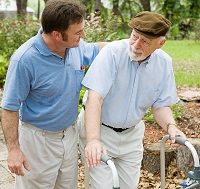Evaluating Walking Devices for Use by Patients with COPD
For patients with chronic obstructive pulmonary disease (COPD), using a frame with wheels, handlebars, and a built-in seat resulted in the longest distance walked and the most time spent walking, according to a recent study.

For patients with chronic obstructive pulmonary disease (COPD), using a frame with wheels, handlebars, and a built-in seat resulted in the longest distance walked and the most time spent walking, according to findings published in the journal Respirology.
Researchers from the Netherlands studied 15 COPD patients performing three self-paced outdoor tests in order to determine if the handlebar/ seat device (which the investigators called a rollator) plus a draisine (a device similar to a bicycle, but without pedals that is instead pushed with the feet) would be effective on outdoor walking tasks in these patients.
The tests were conducted on two consecutive days, with one test taking place without the aid of any device, and the second and third tests using a rollator or draisine in a random order. The participants were instructed to walk for as long as they could at their own pace, but the task ended with a maximum duration of 30 minutes or when the patients felt they needed to stop.
Using the rollator produced the highest walk distance and times in COPD patients, the researchers discovered. Additionally, the COPD patients walked significantly further and longer during tests without rollator devices compared to a draisine-aided test.
“Patients with COPD walked significantly further and longer during unaided walking compared with draisine-aided walking,” lead study author Anouk Vaes said in a press release.
The researchers also noted that the use of draisine resulted in a significantly higher walking speed, fewer strides, greater stride length, and higher step and stride variability, when compared to unaided tests and the use of a rollator.
“A rollator improves the self-paced outdoor walk distance and time in individuals with moderate and advanced COPD and a poor functional exercise capacity, whereas the use of a draisine had a detrimental effect compared with unaided walking,” the authors concluded.
The authors added that prior research on this topic indicated that rollators and other walking aids can improve COPD patients’ mobility and functional exercise in six-minute walking tests. But, the researchers said, those exercises do not reflect walking in daily life — the most frequently reported quality-of-life problem in patients with COPD.